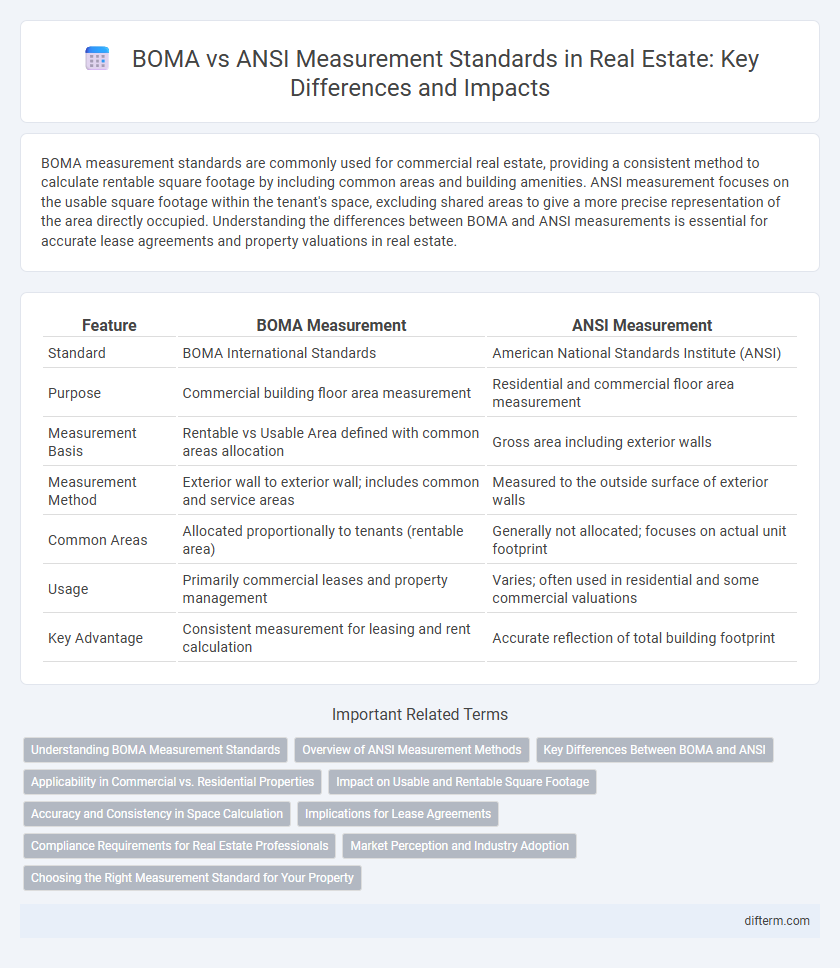BOMA measurement standards are commonly used for commercial real estate, providing a consistent method to calculate rentable square footage by including common areas and building amenities. ANSI measurement focuses on the usable square footage within the tenant's space, excluding shared areas to give a more precise representation of the area directly occupied. Understanding the differences between BOMA and ANSI measurements is essential for accurate lease agreements and property valuations in real estate.
Table of Comparison
| Feature | BOMA Measurement | ANSI Measurement |
|---|---|---|
| Standard | BOMA International Standards | American National Standards Institute (ANSI) |
| Purpose | Commercial building floor area measurement | Residential and commercial floor area measurement |
| Measurement Basis | Rentable vs Usable Area defined with common areas allocation | Gross area including exterior walls |
| Measurement Method | Exterior wall to exterior wall; includes common and service areas | Measured to the outside surface of exterior walls |
| Common Areas | Allocated proportionally to tenants (rentable area) | Generally not allocated; focuses on actual unit footprint |
| Usage | Primarily commercial leases and property management | Varies; often used in residential and some commercial valuations |
| Key Advantage | Consistent measurement for leasing and rent calculation | Accurate reflection of total building footprint |
Understanding BOMA Measurement Standards
BOMA measurement standards provide a comprehensive method for calculating rentable square footage in commercial real estate, ensuring consistency across office buildings and retail spaces. These standards focus on defining usable areas, common spaces, and load factors to offer accurate lease space assessments. Understanding BOMA guidelines is essential for property managers and tenants to negotiate fair leases and optimize space utilization.
Overview of ANSI Measurement Methods
ANSI measurement methods define standards for measuring commercial real estate spaces by focusing on the Usable Area, which excludes structural elements such as walls and columns. These methods provide clear guidelines for calculating the Rentable Area by adding a prorated share of common areas, ensuring consistency in leases and space planning. Compared to BOMA standards, ANSI emphasizes occupant-focused measurements, aiding tenants and landlords in precise space utilization and cost allocation.
Key Differences Between BOMA and ANSI
BOMA measurement standards primarily focus on commercial real estate with a focus on rentable square footage, including common areas and building services, whereas ANSI standards provide detailed measurement guidelines applicable to residential and commercial spaces emphasizing net and gross floor areas. The key difference lies in BOMA's emphasis on usable tenant space for leasing and billing purposes, while ANSI prioritizes consistency in architectural measurements for design and compliance. Understanding these distinctions is crucial for accurate property valuation, leasing negotiations, and space planning in real estate transactions.
Applicability in Commercial vs. Residential Properties
BOMA measurement standards primarily apply to commercial properties, offering precise guidelines for calculating rentable and usable space in office buildings, retail centers, and industrial facilities. ANSI measurement standards, while also used in commercial real estate, provide detailed protocols adaptable to multi-family residential buildings, promoting consistency in floor area calculations. Understanding the distinctions ensures accurate space assessments tailored to the specific requirements of commercial versus residential property leasing and sales.
Impact on Usable and Rentable Square Footage
BOMA measurement standards typically include common areas in rentable square footage calculations, which often result in higher rentable area figures compared to ANSI standards that emphasize clear usable space boundaries. This difference impacts lease negotiations, as tenants may pay for a larger rentable area under BOMA methods despite having less usable space than indicated. Understanding discrepancies between BOMA and ANSI measurements is essential for accurately assessing usable and rentable square footage, directly influencing rental rates and cost efficiency.
Accuracy and Consistency in Space Calculation
BOMA measurement standards prioritize consistency in calculating usable floor space by strictly defining methods for common areas, resulting in reliable space assessments across commercial real estate. ANSI measurement guidelines emphasize precision in capturing exact dimensions, enhancing accuracy for tenant space allocation and lease agreements. Both standards improve transparency in space calculation, but BOMA offers uniformity for multi-tenant buildings while ANSI provides detailed accuracy suitable for customized real estate evaluations.
Implications for Lease Agreements
BOMA measurement standards often result in larger rentable square footage calculations compared to ANSI measurements, directly impacting lease agreements by increasing tenant rental costs. The choice between BOMA and ANSI can affect how common areas are allocated and billed, influencing a tenant's overall financial liability. Understanding these measurement differences is crucial for accurate rent calculations, expense recoveries, and negotiation of lease terms.
Compliance Requirements for Real Estate Professionals
Real estate professionals must understand the key differences between BOMA (Building Owners and Managers Association) and ANSI (American National Standards Institute) measurement standards to ensure compliance with lease agreements and property valuations. BOMA measurement primarily focuses on calculating rentable area for commercial lease spaces, while ANSI measurement is often used for residential and multifamily properties emphasizing usable and gross areas. Adhering to the correct standard mitigates legal risks, supports accurate reporting, and aligns with industry regulatory requirements.
Market Perception and Industry Adoption
BOMA measurement standards are widely recognized for their longevity and consistency, making them the preferred choice among many commercial real estate stakeholders. ANSI measurement standards, while more detailed and precise in calculating rentable areas, have seen increasing adoption due to their alignment with modern leasing and space optimization practices. Market perception favors BOMA for its historical reliability, but industry adoption trends reveal a gradual shift toward ANSI standards as tenants and landlords seek more transparent and standardized measurements.
Choosing the Right Measurement Standard for Your Property
Selecting the appropriate measurement standard between BOMA and ANSI impacts the accuracy of property size representation and leasing terms. BOMA measurements emphasize rentable area including common spaces, while ANSI focuses on the usable square footage within tenant boundaries. Understanding these distinctions ensures effective space planning, lease negotiations, and market comparisons tailored to your real estate goals.
BOMA measurement vs ANSI measurement Infographic

 difterm.com
difterm.com